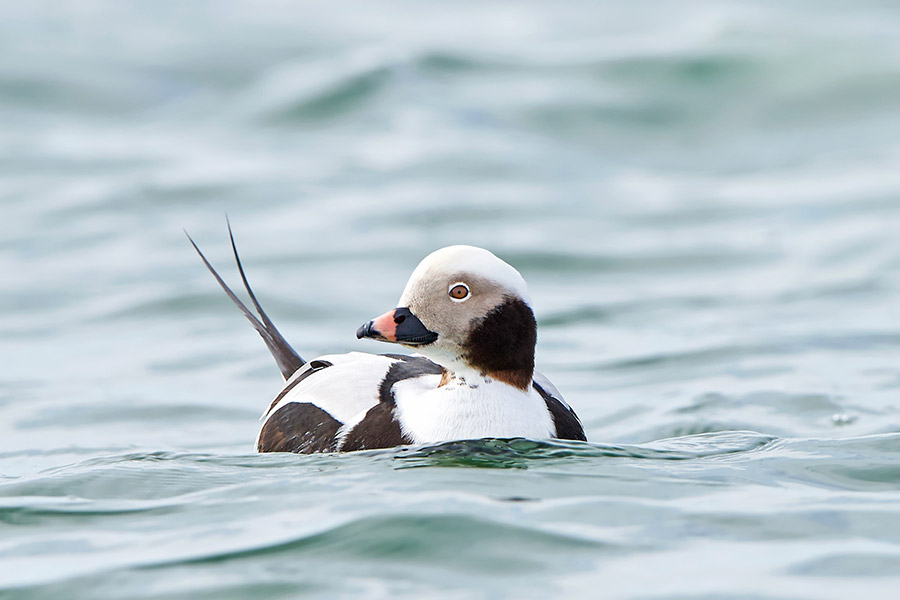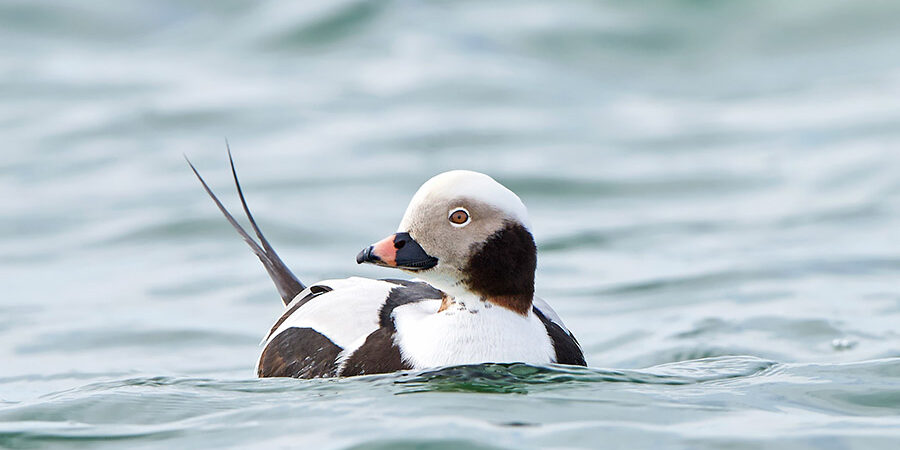Long-tailed ducks (Clangula hyemalis) are a remarkable species of Arctic nesting sea duck commonly seen along Maine’s coast in the winter.
Although long-tailed ducks have a wide distribution throughout high latitudes of the northern hemisphere, we still have lots to learn about this species.
Unfortunately, the global population of long-tailed ducks is listed as Vulnerable by the IUCN.
 Dressed for Success and to Impress
Dressed for Success and to Impress
Long-tailed ducks are dressed for success and to impress. Like other ducks, they have plumage for the breeding season and non-breeding season, but unlike most other ducks, they have another type of plumage:
The website Birdnote explains that:
“Most ducks spend much of the year in their alternate (or less formally, their “breeding”) plumage. Only a few weeks of the year will you find them in their more drab basic (or “winter”) plumage, and that’s usually just following the breeding season in the fall.”
Long-tailed ducks stand out because they:
“have a more complex transformation between three different plumages — alternate, basic, and a supplemental plumage — resulting in a look that changes continually, and dramatically, throughout the year.”
Are these ducks the fashionistas of the duck world? We’ll let you decide.
They Like to Talk
The long-tailed duck is a vocal species of duck. They possess “an extensive variation of calls and sounds integral in interspecies interactions like mating or raising young.”
Many people associate the calling of male long-tailed ducks with the arrival of spring, due to their distinct vocalizations during courtship leading up to the breeding season.
The first part of their scientific name (aka the species’ genus), Clangula, means ‘to resound’ or ‘noisy’, which seems like a fitting description!
Deep Divers
These ducks “tend to stay within a few miles of land or in the relatively shallow waters above offshore shoals. However, they can dive far below the surface.” It’s their tremendous diving ability that separates them from other ducks.
The site All About Birds notes:
“These prodigious divers can feed as deep as 200 feet, swimming with their wings, catching invertebrates and small fish.”
It’s worth noting that the 200-foot diving is based on anecdotal evidence. Nonetheless, the long-tailed ducks are quite the divers when they want to be.
Regardless of how deep the long-tailed duck can dive, its diving is said to be a thing of beauty. Birdnote describes the long-tailed duck’s grace in diving as it propels “…itself beneath the surface with its wings, it seems to fly through the water.” If these ducks competed in a diving event, they would likely get major points for form.
Indeed, there’s lots to love about long-tailed ducks.
What’s in a Name?
The name of the long-tailed duck is derived from “the male’s plumage: long, slender tail-plumes extend almost a foot behind his body.” However, these ducks were also called by a name that is considered offensive—oldsquaws.
The name oldsquaw is no longer used because it is offensive to indigenous peoples. Oldsquaw is a demeaning name that represents centuries of oppression towards Native Americans and is based on an error-riddle translation of a particular people’s language.
Thankfully, modern sensibilities and a greater appreciation for Native culture led to the duck’s name being changed.
Looking to Learn More?
Nature is full of wonders and the long-tailed duck is no exception. Whether it’s the duck’s beautiful plumage, its diving ability, or its fondness for chatter, there are many things to admire about it.
If you’re interested in Maine wildlife, our website has many resources available.
Be sure to visit the Friends of Maine Coastal Islands Wildlife Refuge website where we have information on how to support local wildlife, the latest news on upcoming events, and more.
Visit the Friends of Maine Coastal Islands National Wildlife Refuge blog to learn more about Maine’s coastal wildlife.







